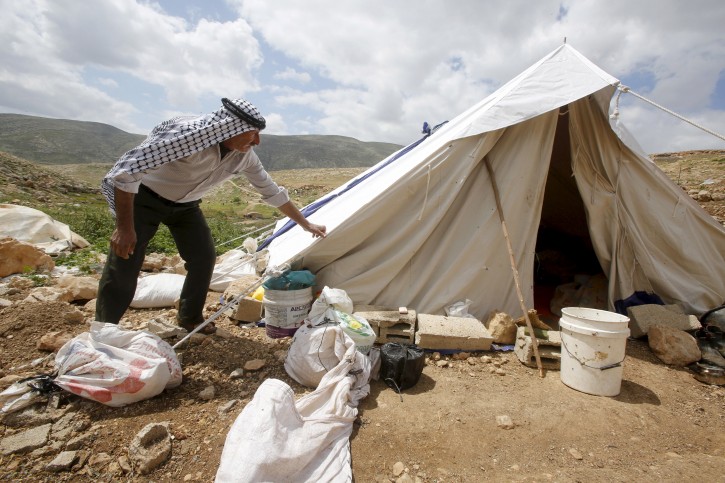 West Bank – When in early March Israeli forces came to this Bedouin village, set among steep, rocky hills in the north of the occupied West Bank, overlooking the Jordan valley, they bulldozed the school, leaving 23 children with nowhere to study.
West Bank – When in early March Israeli forces came to this Bedouin village, set among steep, rocky hills in the north of the occupied West Bank, overlooking the Jordan valley, they bulldozed the school, leaving 23 children with nowhere to study.
Subscribe to our Daily Roundup Email
The European Union came and built a temporary classroom and other prefabricated structures, an effort to help a community of around 40 families, some of them still living in caves, that subsists without electricity or mains water in a part of the West Bank fully under Israeli control, known as “Area C”.
Two weeks later, the Israeli army returned and demolished 17 homes, 21 pens for sheep, goats and chickens, and five outhouses, according to B’tselem, an Israeli NGO.
“The Israelis are quicker at destroying than the Europeans are at building,” said 61-year-old Wassif Hanani, a father of four who has lived in Khirbet Tana all his life, his wind-beaten face cracking at the eyes as he laughed dryly.
The Israeli army says it is simply carrying out court rulings against unauthorized building by Palestinians in Area C. Foreign diplomats and rights groups see it as part of a broader move to seize land for potential Jewish settlement expansion.
When it first came to Khirbet Tana in February, the army arrived with a court order and two bulldozers. The village, about two kilometers (one mile) inside Area C, which covers 60 percent of the West Bank, is near a military firing zone, it said.
That is a common justification given by the military when it wants to carry out demolitions and the forced removal of Palestinians from the land, diplomats and human rights groups say. It does not wash with United Nations officials.
“Declaring the area a firing zone is just an excuse,” said Robert Piper, a U.N. assistant secretary general and the head of humanitarian affairs for the Palestinian territories.
Since the 1970s, shortly after Israel occupied the West Bank in the Middle East war, nearly a fifth of the territory has been closed for military purposes, the U.N. says, even though it is hardly ever used for training or as firing zones.
“The legal arguments we come across we don’t believe are particularly strong,” said Piper, who visited Khirbet Tana on Monday to see for himself the destruction caused.

“The rights of Palestinians in these zones are frankly being denied,” he said, pointing out that on top of the suffering caused by the demolitions, families have had goods, including in some cases their cars, confiscated and seen aid that was meant to help them in the middle of winter destroyed.
In similar cases in the past, Israel has argued that the communities are not fixed, that the Bedouin are effectively occupying unused land and residing temporarily in the caves.
In Khirbet Tana that is a hard case to make. The village is spread across several craggy hillsides, with steep rises all around. The caves have been lived in for generations – one resident was born in the 1930s – and there is an Ottoman-era mosque, built in the 1850s, in the midst of the village.
“This is not a community that arrived yesterday,” said Piper, gesturing to the mosque and a nearby natural spring.
SETTLERS NEAR
The overriding concern for humanitarian officials is that Khirbet Tana is not a one-off. So far this year, Israeli forces have destroyed or dismantled around 400 homes and other structures across the West Bank, more than in the whole of 2015.
Not only has that left children homeless and without school, it has meant a severe loss of income for the farming communities affected. And in some instances there has been the sense of a direct snub to foreign aid, since many of the structures destroyed were put up by the European Union or other donors.
The U.N. office for the coordination of humanitarian affairs says it is among the highest rates of demolitions it has recorded since 2009. Which begs the question, “Why now?”
While Israeli courts have generally backed the military’s actions, diplomats see a more worrying long-term trend.
On the steep peaks above Khirbet Tana, there are illegal Israeli outposts – prefabricated structures, often hooked up to water and electricity, occupied by Jewish settlers. Not even the Israeli government considers them authorized.
There are around 100 outposts in the West Bank, which Israel says it will uproot in any agreement with the Palestinians on a two-state solution. In the absence of negotiations, the outposts grow and gradually become more established. In the past, some have linked up with the settlement blocs Israel does authorize.
An official working with the U.N. shows a detailed map of the area around Khirbet Tana, with illegal outposts marked in purple. They are springing up all around, with the pattern suggesting a slow expansion towards the Jordan valley.
“It starts to look irreversible,” said the official.

Well this doesn’t make Israel look good….